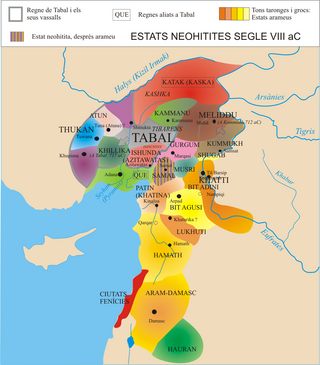
Sheba is an ancient kingdom mentioned in the Hebrew Bible and the Quran. It particularly features in the tradition of Orthodox Tewahedo in today's Yemen and is also asserted as the home of the Queen of Sheba, who is left unnamed in Jewish texts, but is known as Makeda in Ethiopian texts and as Bilqīs in Arabic texts. According to the Jewish historian Josephus, Sheba was the home of Princess Tharbis, who is said to have been the wife of Moses before he married Zipporah.

The Sabaeans or Sabeans were an ancient group of South Arabians. They spoke Sabaic, one of the Old South Arabian languages. They founded the kingdom of Sabaʾ in modern-day Yemen, which is considered to be the biblical land of Sheba and "the oldest and most important of the South Arabian kingdoms".

Deioces, was the founder and first king of the Median kingdom. His name has been mentioned in different forms in various sources, including the Ancient Greek historian Herodotus. He is considered to be the first Median king.

Tabal, later reorganised into Bīt-Burutaš or Bīt-Paruta, was a Luwian-speaking Syro-Hittite state which existed in southeastern Anatolia in the Iron Age.

Maşat Höyük is a Bronze Age Hittite archaeological site 100 km nearly east of Boğazkale/Hattusa, about 20 km south of Zile, Tokat Province, north-central Turkey, not far from the Çekerek River. The site is under agricultural use and is plowed. It was first excavated in the 1970s.

Sapinuwa was a Bronze Age Hittite city at the location of modern Ortaköy in the province Çorum in Turkey about 70 kilometers east of the Hittite capital of Hattusa. It was one of the major Hittite religious and administrative centres, a military base and an occasional residence of several Hittite kings. The palace at Sapinuwa is discussed in several texts from Hattusa.
Some loanwords in the variant of the Hurrian language spoken in Mitanni during the 2nd millennium BCE are identifiable as originating in an Indo-Aryan language; these are considered to constitute an Indo-Aryan superstrate in Mitanni. The words are theonyms, proper names and technical terminology related to horses (hippological).
Shubria or Shupria was a kingdom in the southern Armenian highlands, known from Assyrian sources in the first half of the 1st millennium BC. It was located north of the upper Tigris River and to the southwest of Lake Van, extending eastwards to the frontiers of Urartu. It appears in the 1st millennium BC as an independent kingdom, succeeding the people earlier called Shubaru in Assyrian sources in the later centuries of the 2nd millennium BC. It was located between the powerful states of Assyria and Urartu and came into conflict with both. It was conquered by Assyria in 673–672 BC but likely regained its independence towards the end of the 7th century BC with the collapse of Assyrian power.

Kurda was an ancient city-state and kingdom located in Northern Mesopotamia. Kurda emerged during the Early Dynastic Period (Mesopotamia) and is attested in the administrative texts of this era as a city state and geographical territory in Upper Mesopotamia corresponding to modern northern Iraq. The city-state of Kurda is again attested by the Akkadian king Naram Sin in 23rd century BCE in his military campaigns in the land of Subarians. Various Archives of Mari around 18th century BCE mention Kurda as an independent Kingdom, sometimes in alliance with Babylon and sometimes allied with Mari. Kurda is also mentioned in the Tell Fekheriye tablets of the Assyrian kings Šalmaneser I and Tukulti-Ninurta I, as one of the conquered territories in the Mitannian Empire.
Karen Radner is an Austrian Assyriologist, the Alexander von Humboldt Professor of Ancient History at the University of Munich.
Family tree of the First Dynasty of Egypt, ruling ancient Egypt in the 32nd century BCE to the 30th century BCE.

The Setjet were a people in conflict with the early Egyptian rulers of the First Dynasty of Egypt. One of the year labels of Pharaoh Djer mentions the "smiting Setjet". Setjet was presumably a region to the northeast, or a region of Western Asia.
Tell Hammam et-Turkman is an ancient Near Eastern tell site located in the Balikh River valley in Raqqa Governorate, northern Syria, not far from the Tell Sabi Abyad site and around 80 km north of the city of Raqqa. The Tell is located on the left bank of the Balikh and has a diameter of 500 m and is 45 m high. 500 m north is the modern village of Damešliyye.
Simat-Ištaran was a daughter of King Ur-Nammu, who was the first king of the Ur-III Dynasty in Mesopotamia, at the end of the third millennium BC. Simat-Ištaran is mainly known from cuneiform texts coming from Garšana. According to those texts she was married to the general and physician Ŝu-Kabta. This connection is never explicitly mentioned within the texts, but can be inferred. This marriage documents how the Ur-III Dynasty kings married family members to various important people in the empire. After the death of her husband, Simat-Ištaran inherited his estate and continued to manage it alone.

The Sabean colonisation of Africa was a process of colonization by Sabeans that occurred in the Horn of Africa during the first millennium BC.

Suppiluliuma, possibly Suppiluliuma II or III, was the king of the Neo-Hittite state of Pattin in the mid-ninth century BC.

Atuna or Tuna was a Luwian-speaking Syro-Hittite state which existed in the region of Tabal in southeastern Anatolia in the Iron Age.

Ištuanda or Ištunda was a Luwian-speaking Syro-Hittite state which existed in the region of Tabal in southeastern Anatolia in the Iron Age.

Šinuḫtu was a Luwian-speaking Syro-Hittite state which existed in the region of Tabal in southeastern Anatolia in the Iron Age.
 .
. .
. .
.








